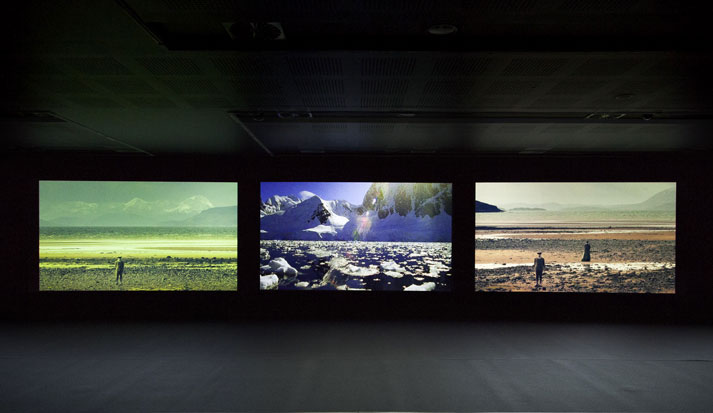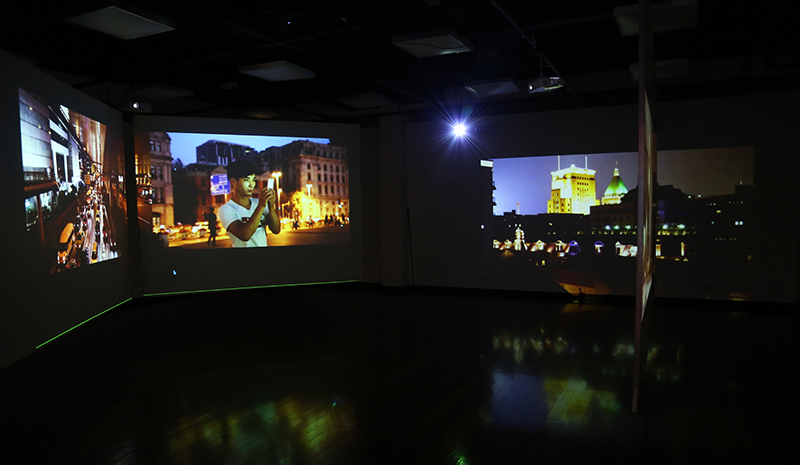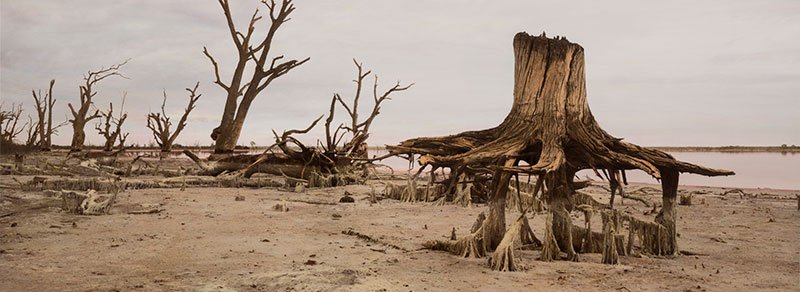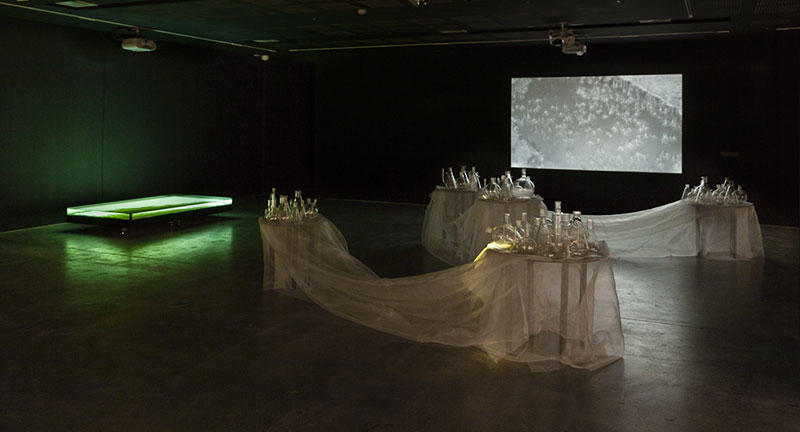
Troubled Waters is a grand, multilayered three-part installation on a planetary scale. The vastest canvas, Vertigo Sea: Oblique Tales on the Acquatic Sublime, by British artist John Akomfrah is also historical in reach. Across three full-scale cinematic screens, the sublime drama of the ocean in all its horror and glory is played across an intense montage with a blistering film score. Mass migrations of vast flocks of seabirds, filmed from a great height, are captured whirling across kilometers of oceans and swamplands. Swathes of red blood from harpooned whales float on the ocean like broad brushstrokes of abstract painters, while, underwater long tendrils of seaweed stream in forceful currents. Old sepia footage from early cinema shows a stumpy and agile sailor dancing the hornpipe; contemporary refugees are dragged from sinking boats; and huge pipeline waves, flexing their power, fill the interstices conjoining the vast narrative spanning centuries.
The surges of this swirling drama are punctuated by blank screens carrying snatches of sea-themed text by famous authors, including Herman Melville’s heroic tale of whaler Captain Ahab in Moby Dick and the introspection of Virginia Woolf’s To the Lighthouse. In addition, as if the three giant screens were not sufficiently burdened with spectacle, costumed performers gaze out to sea enacting scenes from famous paintings of the maritime sublime. An actor, in three-cornered hat, stockings and frock coat, imitates the pose of Casper David Friedrich’s lone contemplator in various maritime panoramas, including Wanderer Above the Sea of Fog (1818), while other lonely men and women gaze out at fully rigged ships at sea, in the manner of Friedrich’s The Stages of Life (1835).

The result, for all this magnificence, borders on grandiloquence. The ticking of clocks in the sound floor drives home the point of the traversing of centuries. But when fifty or so ticking alarm clocks manifest en masse – Surrealist style – on a sandy beach, the visual metaphor of passing time becomes hyperbolic as do the many repeat appearances of the performers in period costume. At times, the work feels overdone, particularly in those scenes of surreal disjuncture where too many lone humans posing with various remnants of civilization – rusty bedsteads, lamps, chairs and chests of drawers strewn through the landscape – are randomly placed as if to convey our human inability to master or make sense of the world. One or two such scenes would have better sufficed. Yet those scenes were pivotal to the undermining of the eighteenth-century pomposity of painting’s staged sublime and its sense of conquest by the eye. That said, much of the footage is simply breathtaking. Sourced from prestigious natural history institutes, it rivals Terrence Malik’s The Tree of Life (2011) for scale and grandeur, while conveying the dominant message of the planet’s unconquerable oceans.
By contrast, Georgia Wallace-Crabbe’s equally spectacular five-screen The Earth and the Elements was tempered by a documentary realism. Similarly sublime moments of spiraling dust and gigantic sprays of spurting water gave way to the disheartening reality that dangerous coal dust was being dampened down in an open-cut mine. Equally thrilling footage of the trembling mass of a coal-blast likewise flirted with the sublime, but was deflated by activist considerations.

Filmed across a number of locations in Australia, Wallace-Crabbe included the 2012 People’s Conference that called for no more coal mines on the prime agricultural lands near Mudgee. Banners of displaced farmers read “Coal Costs the Earth” and “Food Bowl Not Coal Hole”. Alongside Indigenous dissenter, Lorene Samson, Nell Schofield of Lock the Gate and Our Land, Our Water, Our Future and international environmentalist and geo-consultant, Chris Pavich of National Parks and Wildlife NSW lamented the losses in what The Guardian has described as the largest movement of earth in the planet’s history. Literally, massive chunks of Australia’s earth are being displaced to China in the form of coal and iron ore.
The elements referred to in the title relate to the Taoist concepts of the Five Elements or Five Phases – Wood (coal), Fire, Earth (iron ore), Metal and Water – ironically, all elements or phases of the transformation of Australian raw materials in the furnaces and factories of China. This ancient system described the main interlocking systems that governed the universe – a universe that is now governed through the intermeshing of Australian–Chinese trade.
Wallace-Crabbe highlights the magnitude of these flows of materials and their transformation – and the relentlessness of it. For what felt like minutes, the endless line of an Australian coal train rattled across all five screens. In Shanghai, footage of ten lane freeways was intercut with massive container depots and a Chinese bride on the Bund being photographed in a Western style “meringue” wedding dress that was luridly aqua-blue. The narrative seemed to be leading this way: all that digging up, destruction and transportation; was it for this, the final transubstantiation of matter into the kitschy froth of a non-traditional wedding frock? China, its architecture, and its culture, was likewise being transformed.

Overall, the dominant message was of relentlessness, a deranged intermeshing of forces in which the hope of environmental protectionists and actionists was drowned. Thus the impressive images of mining porn or bling – aesthetic sublimes of dust and molten metal – were tinged with the sober dose of a reality check in the uneasy mix of images. As with the Akonfrah, viewers need to watch the full cycle: these works make little sense when sampled.
River Journey more specifically had a local focus on Australia’s ailing Murray Darling River system. Andrew Belletty, Nici Cumpston, Tamara Dean, Bonita Ely and Janet Lawrence presented a multifaceted portrait of a river in distress. Photomedia dominated, with vast tracts of dead and dying gums cycled across many works evoking the spectacle of disaster. Tamara Dean photographed river scientists at work. Andrew Belletty complemented aquatic floor installations and a river fly-over with immersive sound.
Janet Lawrence’s multimedia installation was the most compelling. Her trademark glass vessels, filled with drinking water, sat like flasks on a riverbank over a flowing river of semi-transparent white fabric onto which were projected the ghostly swimming skeletons of tiny fish and micro organisms. This highlighted the disconnect between town and country, between the life-supporting water of fragile inland river systems and, a world away, the sterile product of filtered city water from plentiful coastal dams.


